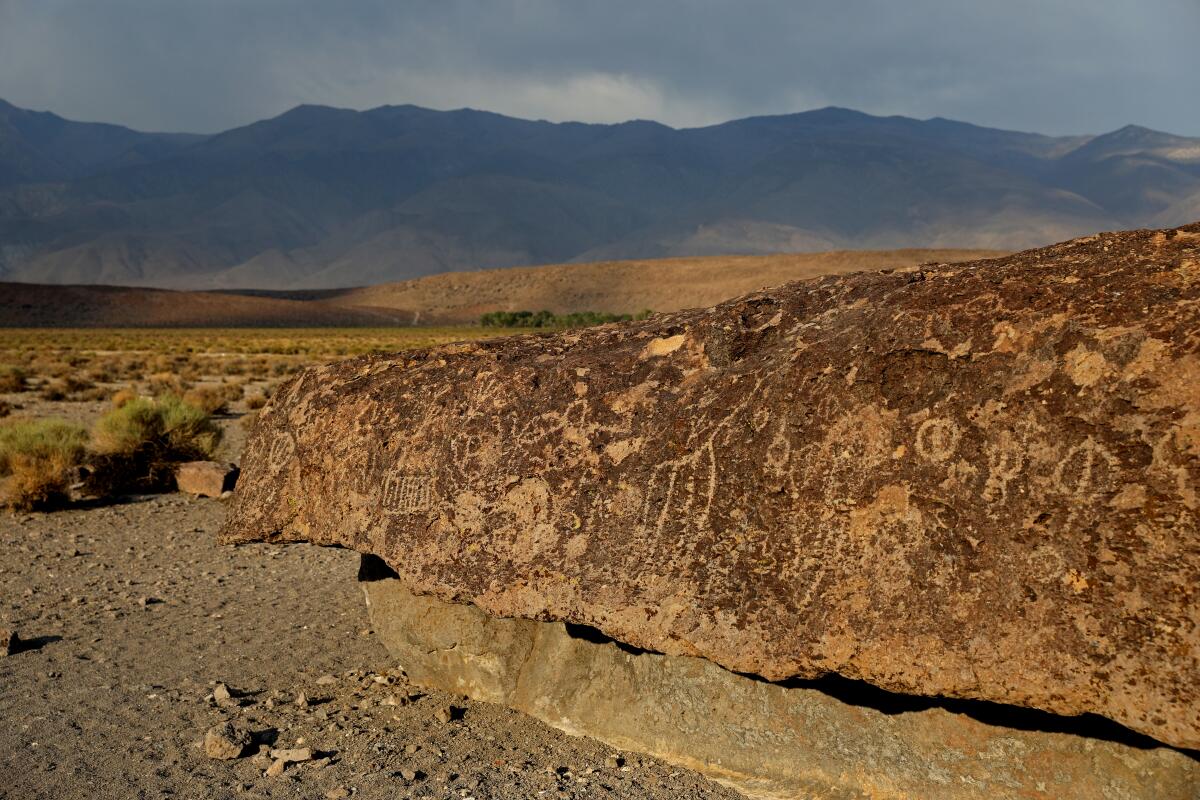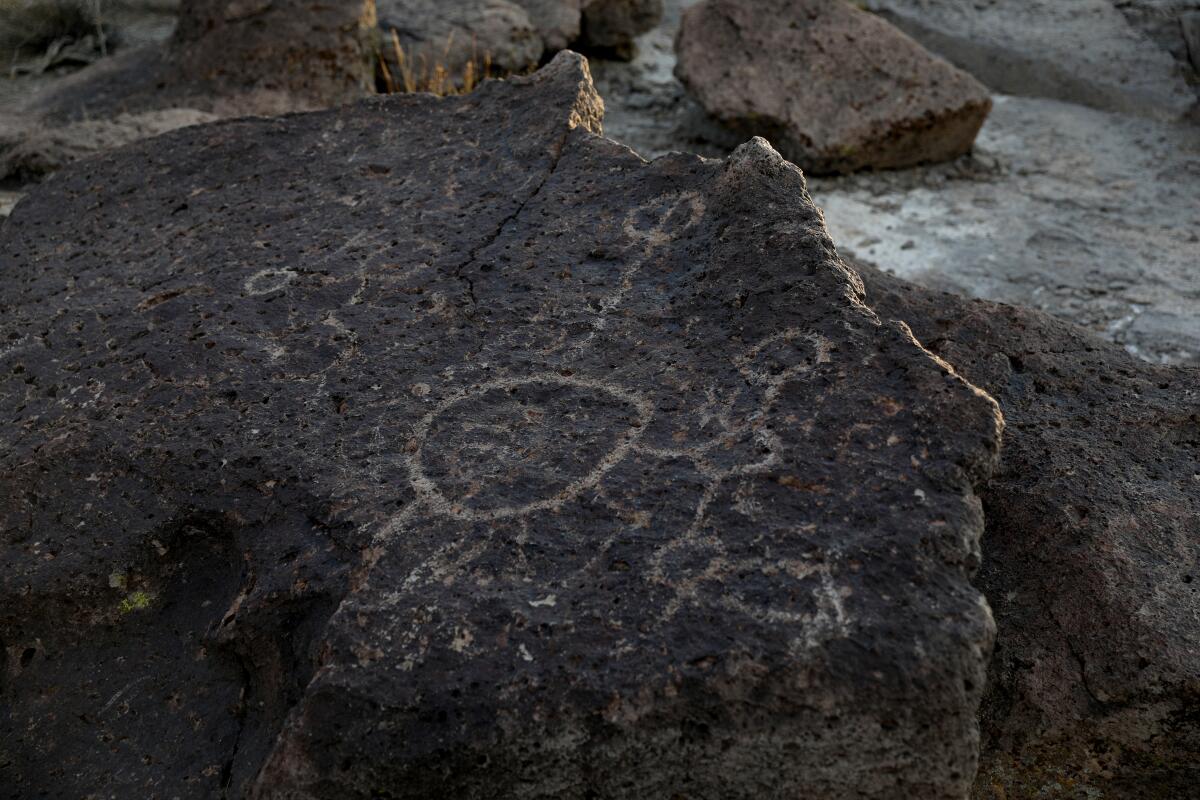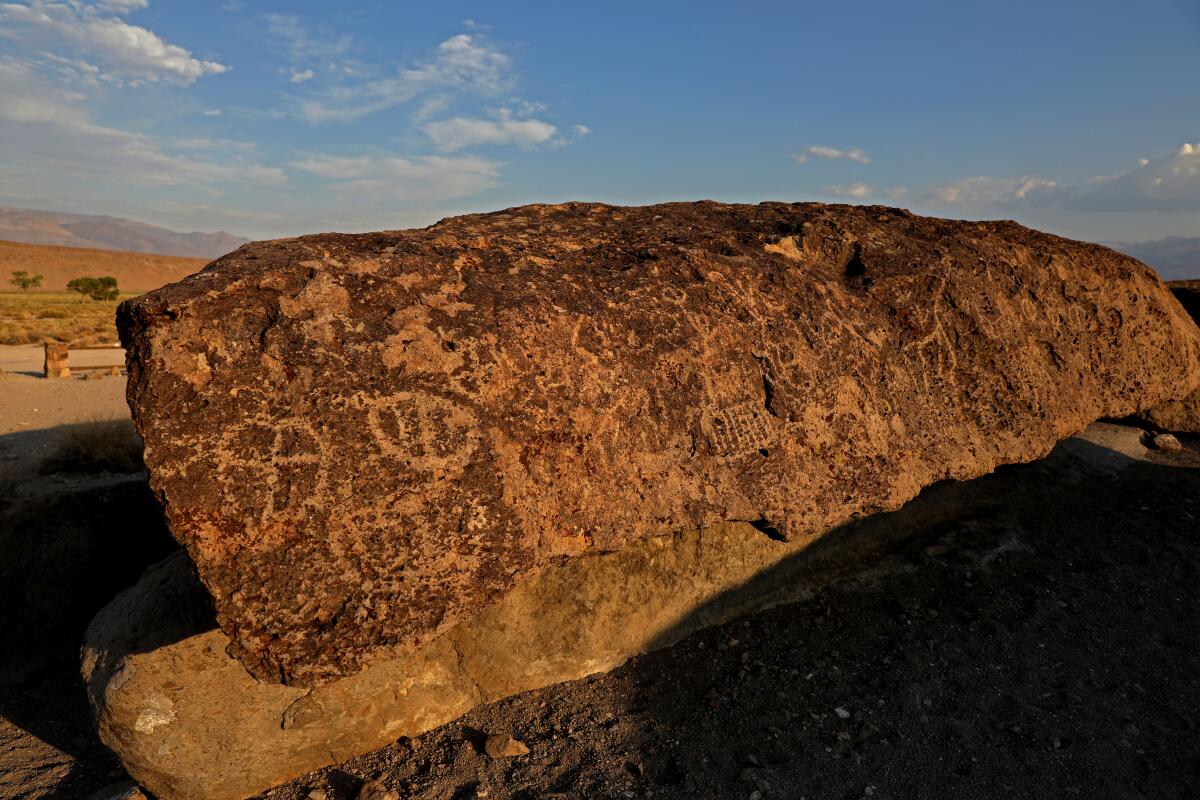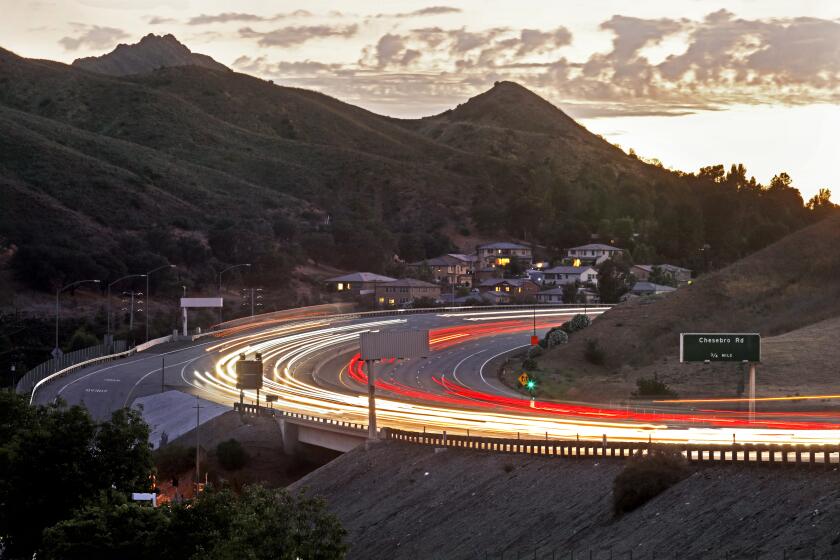Caltech says it regrets drilling holes in sacred Native American petroglyph site

- Share via
BISHOP, Calif. — Inside federal Ranger Chris Mason’s patrol truck, the radio crackled with alarming news: People were seen lugging bags of heavy equipment into a protected site containing prehistoric rock carvings.
Archeologists know the site as the Volcanic Tablelands, an otherworldly landscape of pink-hued cliffs and terraces shaped by wind, rain and earthquakes. It was also an area where it was not unusual to find looters armed with shovels and saws prowling for anything that could be sold in the illegal antiquities market.
But when Mason arrived at the scene on Earth Day 2017, he determined that the suspicious activity involved a faculty member and students from Caltech, the prestigious private research university in Pasadena known for its strength in science and engineering, and for managing NASA’s Jet Propulsion Laboratory.
Joseph Kirschvink, a professor of geoscience, had used a portable pneumatic drill to extract core samples for paleomagnetic studies, officials said. He drilled into rock face roughly three feet from a petroglyph and left the site riddled with 29 1-inch diameter holes marked with blue paint.

Illegal marijuana grows have exploded across the California desert, along with forced labor, ecological destruction and fear
The trouble is, Kirschvink was not authorized to conduct research in the area designated to be of critical concern in California’s eastern Sierra Nevada, and that was the reason he and Caltech came under investigation for violating the Archeological Resources Protection Act.
The site, near Bishop, is administered by the U.S. Bureau of Land Management. The expansive petroglyph site is one of the oldest recorded in the West and easily accessible by road. A placard at a popular viewing site roughly one mile north of where the damage occurred warns visitors that “no person may excavate, remove, damage or otherwise deface any archeological resource.”
It took four years to resolve the case due to delays caused by the pandemic, and the strict requirements and complexities of the agency’s forensic protocol and damage assessment procedures, officials said.
Kirschvink did not respond to requests for comment.
Native Americans, archeologists and federal land managers have long complained that unlawful removal and destruction of artifacts and sacred sites destroy priceless cultural connections, along with scientific data that allow a better understanding of the earliest inhabitants of North America.
An uptick in unauthorized incursions by university professors armed with geology picks and pneumatic drills in recent years has only compounded their frustrations. The area is known for its Bishop tuff — a type of rock formed by super-heated volcanic ash, which is of interest to researchers.
“Those formations and the prayers etched into them so many thousands of years ago belong to the public,” said Kathy Jefferson Bancroft, tribal historic preservation officer for the Lone Pine Paiute-Shoshone Reservation. “They are not sources of raw material for unpermitted academic studies.”
Architect Robert Rock is designing a bridge over the 101 Freeway in Agoura Hills that will stop mountain lions from becoming roadkill.
Linea Sundstrom, co-chair of the nonprofit American Rock Art Research Assn.’s conservation and preservation committee, agrees.
“There’s no excuse for it,” she said. “It’s bad education if university professors are not making their students aware of laws protecting archeological sites on public lands.”
Beyond that, Barbara Bane, archeological curator at the Maturango Museum in Ridgecrest, Calif., wondered aloud: “Are these university professors actually saying they couldn’t have gone someplace else to drill their holes? Really?”
The answer to that question is reflected in the penalties meted by Bureau of Land Management officials after lengthy investigations.
Caltech in June agreed to pay $25,465 to the Department of the Interior to cover the costs of repairing damage from the drilling, which the Bureau of Land Management concluded was “inadvertent.” Under the terms of the agreement, it also promised “meaningful academic and educational outreach about the importance of obtaining appropriate federal permits before conducting research on public lands.”
In a statement, Caltech said, “While this was an isolated incident that took place more than four years ago, we deeply regret the damage caused to public lands, especially in light of this area’s sacred meaning to local tribal groups.”
“Going forward,” it added, “Caltech will conduct academic and educational outreach to promote fuller understanding, appreciation, and respect for the importance of clear authorization before undertaking research with the potential to affect geological or archeological resources in any way — both within our community and the broader geosciences field.”
It’s not just Caltech.
The University of Texas at Dallas in 2018 paid $19,842 in connection with 41 holes drilled two years earlier without authorization into a rock art site on agency land just over the Nevada border, about 25 miles east of the Volcanic Tablelands.
That research was led by John Geissman, 69, a university professor at the time, who said he deeply regrets the incident.
“I made a big mistake, and it haunts me to this day,” said Geissman, who recently retired. “I have obligations as a geoscientist and a human being to do the right thing.”
As required under terms of that university’s 3-year-old settlement with the Bureau of Land Management, Geissman said he is working on an article to be published in an American Geophysical Union journal that “will include a sufficiently detailed section on my mistake.”
“Honestly, I recognize that I have been slow on this,” he said. “For the past few years I have been trying to graduate all my PhD students in a timely fashion, and that involves a lot of editing of many versions of manuscripts for publication.”
Then there was Cal State Northridge, which in 2008 paid $25,397 to settle a case that involved the unauthorized drilling of 41 1-inch holes into a petroglyph site on agency land about 15 miles south of Bishop.
Critics believe untold other drillings have gone unreported in volcanic landscapes across the West since paleomagnetic studies emerged as an important scientific endeavor in the 1950s.

At the 36,000-acre Volcanic Tablelands in Inyo County, geology runs wild: Cinder cones streaked with orange and red rise from desert badlands, along with sharp-edged cliffs and boulders that were created by a cataclysmic explosion 760,000 years ago.
Fish Slough, a National Natural Landmark on the eastern edge of the tablelands, includes vivid petroglyphs chipped into bizarrely eroded volcanic tuff formations that overlook a verdant desert oasis laced with meandering spring-fed creeks.
For researchers, its stark geological wonders contain detectable evidence of prehistoric shifts in the ability of Earth’s magnetic field to shield the planet’s surface from cosmic rays. Some researchers suggest these shifts may have influenced global climate and the evolution of species and entire ecosystems — from deep-sea vents to rainforests.
For Native Americans, however, the pictorial outbursts of sun discs, spirals, zigzags, deer, sheep, snakes and human figures etched into cliffs and boulders by prehistoric clans over scores of generations are part of a living spiritual world.
They tell cryptic stories of the past, when the climate was cooler and wetter, and when man lived closer to nature.
Many of the images were carved into desert varnish, a thin red to black coating found on exposed rock surfaces.
Bureau of Land Management officials said the university-related incidents were reported by volunteer “petroglyph patrols” organized by the California Archeological Site Stewardship Program.
Mason was unavailable for comment. But David Lee, a stewardship program member and independent rock art researcher, recalled, “I’m the one who turned in the Caltech group.”
“Immediately after I spotted them,” he said, “I shot into town and notified BLM authorities. A short while later, Ranger Mason arrived at the scene.”
In Lee’s view however, the problem is far from solved. There is no petroglyph site on public land in the United States that is not at risk right now from vandalism, he said.
More volunteers are needed to keep an eye on these engraved messages from the past, Lee said, because federal land managers are overwhelmed by ever-increasing numbers of visitors.
“Why should we care? Because these images are still considered sacred by the descendants of the people who made them.”








